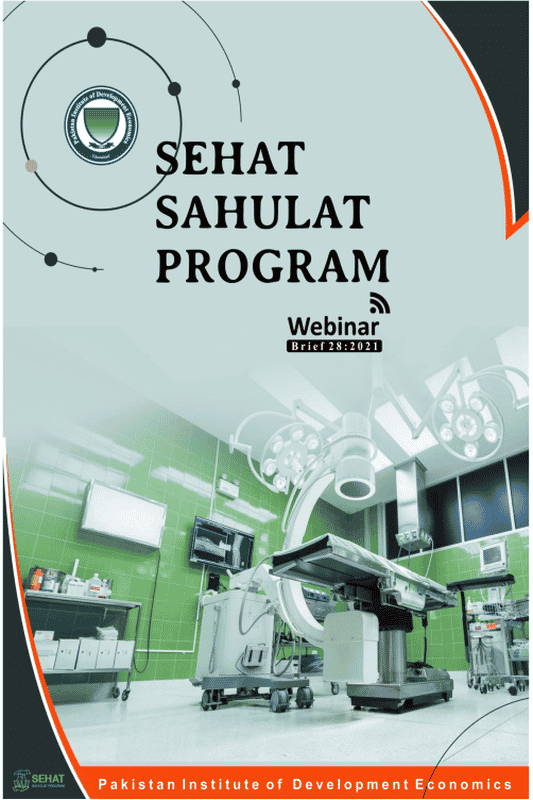
Pakistan Institute of Development Economics
- Home
Our Portals
MenuMenuMenuMenuMenuMenuMenu - ResearchMenuMenuMenuMenuMenuMenuMenu
- Discourse
- The PDR
- Our Researchers
- Academics
- Degree Verification
- Thesis Portal
- Our Portals
Sehat Sahulat Program
Sehat Sahulat Program
Dr. Sania Nishter acknowledged the intellectual inputs by the academics and argued that if public policy is not well informed by regress evidence then there are chances of the mistake right at inception. It is not just at inception; evidence needs to inform all aspects of public policy such as formulation, implementation, and monitoring.
Overview of the Sehat Sahulat Program
The Sehat Sahulat program is the social health protection initiative of the federal and the participating provincial governments. It is started from the below poverty line families based on national socio-economic registry data. The families below the poverty provided by the health-card through which they can get indoor hospitalization services from the panel hospitals.
The program was designed with keeping in view the catastrophic health expenditures that families have to bear to get indoor health services. The treatments, which are being offered by the program, are those treatments for which the families spend most of their income. If they have those diseases happen or the treatment has to be sorted and the families sell their assets and savings just to get those treatments from the hospitals. Therefore, keeping in view those activities, the program was designed just to provide financial protection to the families against those catastrophic health expenditures.
The services which are being covered by the program include oncologist services, cardiology services which include heart stents, open-heart surgeries, etc. in minor surgery this program is also providing medical procedures, to the patient who has to be admitted. It also covers the cancer treatment services such as chemotherapy, radiotherapy, and surgical intervention(s) which are required for the debunking of the cancers. Besides, this program provides the treatment services related to renal failure, burn management, and ventilator support if the patient(s) is required. Inspiringly, now this program is expanding to other families as the government of KPK expanded this program to all those people who have permanent residence addresses of KPK on their CNIC. Similarly, it also expanded to all permanent residents of Islamabad and AJK residents. The officials of provinces Punjab and Gilgit are also working on the expansion of this program to the people of respective districts. However, unfortunately, the program has not started yet in Sindh and Balochistan. The reason behind this is the 18th constitutional amendment in which the responsibilities have been shifted to provincial governments. Moreover, the government is working to improve the quality of the services that are provided to families.
Concerns over Sehat Sahulat Program
Welfare is very much a priority for the present government. The AHSAS program is the main instrument through which that is being achieved. It started as a multi-component program back in March 2019. The Sehat Sahulat program was a very important and influential initiative but it also has limitations. The executing agency for the Sehat Sahulat program is the Ministry of National services. One of the gaps is that not all hospitals are in the panel and many public hospitals are not in the panel too. The poor people land in public hospitals because they are more feasible for them. After all, these hospitals are going through the Sehat Sahulat program. The officer of the planning commission of Pakistan has made the following concerns:
- Limited numbers of health facilities.
- Public hospitals are not acting as independent entities. They are getting the budget from the government and they are coming through the Sehat Sahulat program as well. This core challenge also needs to be addressed.
- No utilization of the health insurance schemes among the enrolled families.
- There is a certain need for a robust public institution structure to audit the ongoing work.
- There is also a need for the business plan and exit strategy.
The scale of operations required third-party comprehensive monitoring and evaluation.
Sehat Sahulat Program – Way Forward
It is claimed that the expenditure in the health sector improves the health of the public in general and the labor force in particular which leads to higher productivity. Furthermore, evidence shows that a 1 percent change in health expenditures can potentially increase GDP per capita by 0.38. Health-related spending shares of household incomes are declining; rural people spend more to buy health care privately indicating health services inequality, a significant factor for high disease prevalence rates and health problems in these areas. The Sehat Sahulat program prioritizes the vulnerable, effectively leveraging the private sector. Sehat sahulat covers all high-cost treatments, and maternity care, cancer, and renal dialysis, and others. From an effectiveness perspective, it does provide good value for money in multiple settings.
Dr. Mahmood Khaild from PIDE has made the following observations:
- Twenty-four (24) percent of the total OPP (out of pocket) expenditures are incurred on in-patient (IP) services while OPP spending as outpatient care for their illness is 29%. About 47% are spent on Medical Products, Equipment & Appliances.
- Costs related to rehabilitation, initial referral, medicines, and revisits are not included.
- Cost efficiency by design is not possible as its non-voluntary or co-financed. Moreover, evidence shows a lack of willingness beyond the limit as well.
- The targeting of the population is also weak: what type of cause and age are taking.
- Public finance usually addresses only the direct cost of care.
- Scaling up by including OOP (extremely poor to vulnerable)
Required Course of Action
- Need to have a road map of which health insurance can be one component; medical care, and medical insurance, and pharmaceutical industry.
- Empaneled hospitals do not include government hospitals.
- HMIS (Health Management Information System) dashboard for the Sehat Sahulat program is not working.
- The Political economy of financing (provincial government sharing the burden)
- Government provision of the therapeutic services (Consider Primary Health Care to manage outpatient system).



